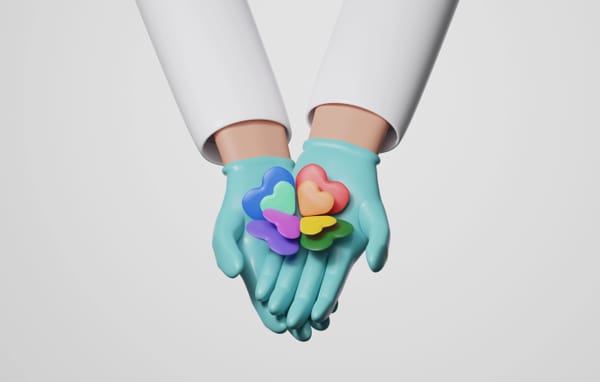Self-Care Beauty Rituals for Identity and Confidence

Beauty rituals often get a reputation as simple ways to enhance your physical appearance, but for many people, they are transformative acts of self-care, self-expression, and self-love. If you're transgender, these rituals can take on even deeper meaning, offering you a space to reconnect with your body, express your gender identity, and combat body dysmorphia. Beauty routines, such as skincare, makeup, and haircare, can be powerful tools for building confidence and nurturing your identity during your transition.
Body dysmorphia, especially when intertwined with gender dysphoria, can create a negative and distorted relationship with your physical appearance. Beauty rituals give you the opportunity to challenge these negative thoughts, replace them with positive affirmations, and ultimately help you feel more comfortable in your skin. In this guide, you’ll learn how beauty rituals can be not just acts of self-care, but also essential practices for overcoming body dysmorphia and nurturing both your identity and your confidence.
Understanding Body Dysmorphia and Its Connection to Gender Dysphoria
Before diving into beauty rituals, it's important to understand how body dysmorphia manifests, especially for transgender individuals. Body dysmorphia, or Body Dysmorphic Disorder (BDD), refers to an obsessive focus on perceived flaws in your appearance. For transgender individuals, these perceived flaws are often rooted in gender dysphoria—the distress experienced when your body doesn’t align with your gender identity. This can manifest in a heightened preoccupation with physical traits such as facial features, body shape, or voice, and can lead to deep dissatisfaction with one’s physical appearance.
During transition, dysmorphia can be compounded as individuals work to express their gender identity through their appearance. Beauty rituals become more than just routines; they become essential practices for nurturing self-love and affirming one’s true identity. When approached mindfully, these rituals can gradually shift the focus away from self-criticism toward self-care, so that you can develop a healthier relationship with body and a stronger sense of self-worth.
The Healing Power of Skincare: Creating a Positive Connection with Your Body
Skincare is often one of the first beauty rituals people adopt, as it provides a simple and effective way to care for the skin. For transgender individuals, skincare can be a powerful tool to reconnect with their body and feel a sense of comfort during a time of emotional and physical change. Regular skincare routines—whether it's cleansing, moisturizing, or applying masks—offer an opportunity to focus on your skin in a nurturing and nonjudgmental way.
The act of touching and caring for your skin can help reduce the negative self-talk often associated with dysmorphia. It’s a way to express love and appreciation for your body, even when some parts of it may feel difficult to accept.
How skincare rituals help overcome body dysmorphia:
- Rebuilding a positive relationship with your body: Skincare routines help individuals reconnect with their physical form in a positive way, focusing on nourishing and caring for the body instead of obsessing over perceived flaws.
- Creating a grounding practice: Taking the time to care for your skin provides a moment of mindfulness. It encourages you to focus on sensations of touch and texture, helping to reduce anxiety and shift focus from negative thoughts to self-care.
- Improving appearance: When the skin looks and feels healthy, it can provide a boost to confidence. Clearer, more vibrant skin can counter feelings of self-consciousness and help create a sense of ownership over your appearance.
By turning skincare into a ritual of love and care, individuals can slowly dismantle the negative perceptions associated with dysmorphia and replace them with self-compassion.
Makeup as a Tool for Identity Expression and Overcoming Dysmorphia
For many transgender individuals, makeup is a crucial part of their beauty routine. Makeup offers an opportunity to affirm gender identity by accentuating certain features and softening others, thus creating a more gender-affirming appearance. For those experiencing gender dysphoria or body dysmorphia, makeup can provide a sense of control and comfort, transforming how they feel about their appearance.
Makeup can be a therapeutic practice, helping to shift the focus away from self-criticism and toward creative self-expression. When used thoughtfully, makeup can be an act of empowerment by creating a look that aligns with your true gender identity.
How makeup rituals help overcome body dysmorphia:
- Affirming gender identity: Makeup is a powerful tool for self-expression, allowing individuals to enhance features that align with their gender identity. Whether it’s contouring to create a softer or sharper facial structure or choosing colors that highlight your gender expression, makeup can serve as a means of aligning your external appearance with how you feel inside.
- Building confidence and reducing dysmorphia: By using makeup to enhance facial features, individuals can begin to see a reflection in the mirror that aligns with their true self. This process can significantly alleviate feelings of dysmorphia by softening the negative focus on features that cause distress.
- Transforming self-perception: The creative nature of makeup allows individuals to experiment and find what makes them feel most like themselves. This experimentation can lead to greater comfort with one’s appearance and less reliance on external validation.
Hair Care: Reclaiming Identity and Confidence
Hair can be a key defining feature of gender expression. It provides a way to affirm gender identity, and for those experiencing body dysmorphia, the act of styling, cutting, or coloring hair can create a sense of control and relief. Taking the time to care for your hair, whether it’s through regular washing, conditioning, or styling, allows you to create a look that feels more reflective of the true you.
How hair care rituals help overcome body dysmorphia:
- Affirming gender through style: Hair plays a major role in gender expression. Choosing a haircut or style that aligns with one’s gender identity can help individuals feel more congruent with their self-image, which can reduce feelings of dysmorphia.
- Creating comfort in appearance: A hairstyle that feels right can significantly improve self-esteem. By shaping one’s hair in a way that reflects their gender identity, individuals are able to build a stronger connection between their external appearance and internal self.
- Building self-confidence: A fresh haircut or color can be an exciting way to take charge of one’s appearance. Feeling in control of how your hair looks can boost confidence and help you feel more empowered in your body.
Small Rituals, Big Impact: Nail and Body Care
Though often overlooked, nail care and body care routines can also play a key role in body dysmorphia and building confidence. Whether it’s through regular manicures, painting nails, or simply moisturizing the body, these small rituals are ways to practice self-love and nurture one’s appearance.
Body care rituals—like applying lotion, scrubbing, or exfoliating—encourage individuals to focus on their skin in a loving, non-critical way. These practices can help build a positive relationship with the body, which is crucial for overcoming dysmorphia and gender dysphoria.
How nail and body care rituals help overcome body dysmorphia:
- Mindfulness and care: By focusing on the act of nail painting or body moisturizing, individuals can engage in a calming, mindful practice that helps reduce anxiety and negative self-talk. This shift in focus from criticism to care can gradually reduce the effects of dysmorphia.
- Building pride and confidence: Nail care and body routines allow individuals to take ownership of their appearance. Simple acts like painting nails or applying body lotion create moments of self-respect and self-affirmation, which can improve overall body image.
- Relaxation and grounding: Body care rituals are often relaxing and help individuals reconnect with their physical form in a positive way. By turning these rituals into calming self-care practices, individuals can counterbalance feelings of discomfort and stress caused by dysmorphia.
Nail and body care routines, though small, offer moments of self-love that can help individuals focus on the positive aspects of their appearance and nurture a healthier relationship with their body.
Mindfulness in Beauty Rituals: Shifting Focus from Dysmorphia to Self-Love
Mindfulness—the practice of being fully present in the moment—can greatly enhance the benefits of beauty rituals. When combined with beauty routines, mindfulness encourages a shift from critical self-perception to compassionate self-care. Whether it’s during skincare, makeup application, or hair styling, practicing mindfulness allows individuals to focus on the present moment and the feelings of relaxation and self-compassion that come with each ritual.
How mindfulness enhances beauty rituals:
- Shifting focus to self-care: Mindfulness encourages individuals to focus on the sensations and positive experiences during their beauty rituals, rather than fixating on flaws or perceived imperfections.
- Reducing negative thought patterns: Mindfulness helps individuals manage negative self-talk and anxiety. By staying present and focused on the act of self-care, individuals can reduce feelings of distress and dysmorphia.
- Affirming self-worth: During beauty rituals, individuals can incorporate affirmations of self-love, such as "I am beautiful," or "I am worthy of care." These affirmations can reinforce positive thinking and relieve feelings of body dysmorphia.
Online Retailers Specializing in Transgender-Specific Beauty Products
The following brands cater to diverse needs and emphasize inclusivity in their product offerings.
- Jecca Blac: Inclusive makeup brand focusing on the needs of the trans community, including products for beard shadow coverage and tutorials.
- Dragun Beauty: Makeup brand founded by a trans woman, offering products like color correctors and setting powders designed with trans women in mind.
- Milk Makeup: Gender-inclusive vegan makeup and skincare brand that supports LGBTQ+ communities.
- Noto Botanics: Gender-fluid, natural cosmetics with proceeds supporting LGBTQ+ causes.
- Equal Love: Genderless natural personal care products celebrating diversity



